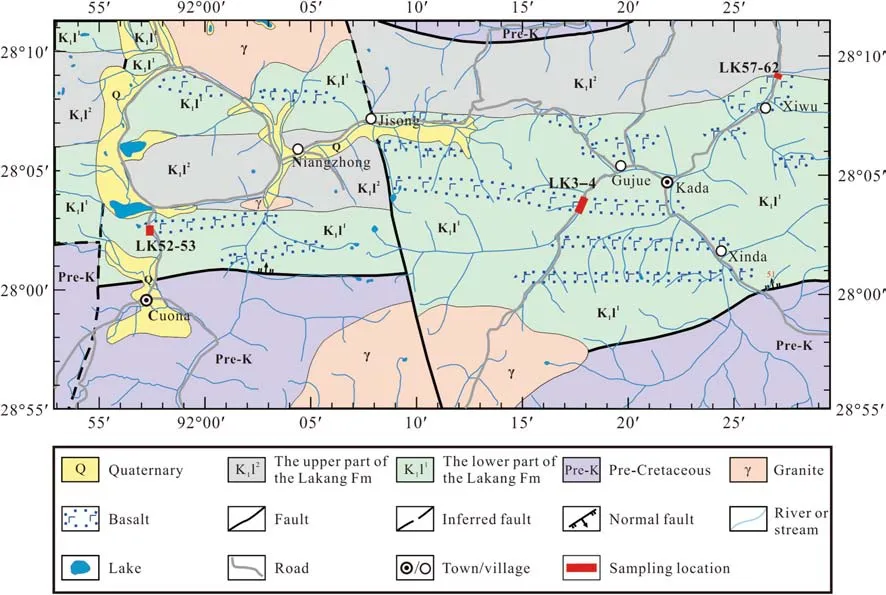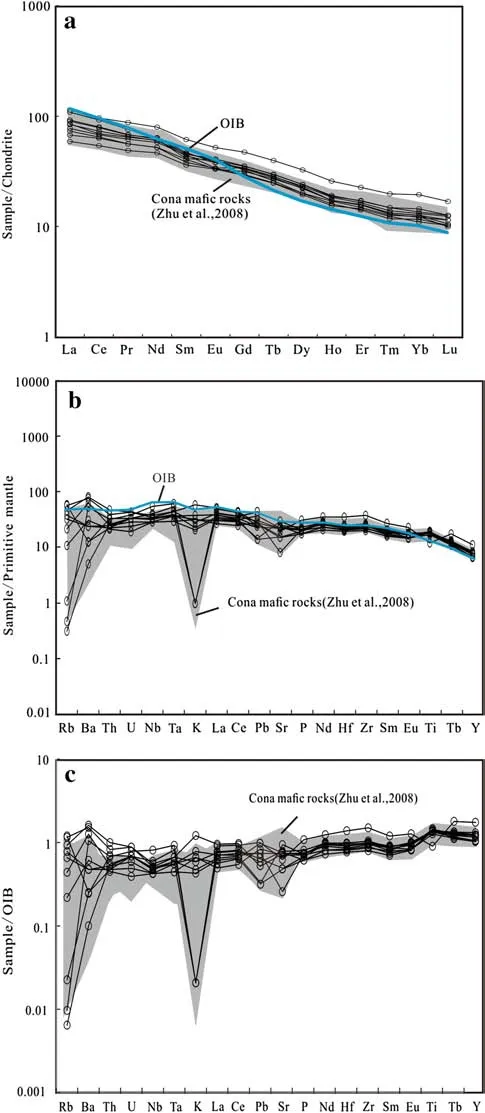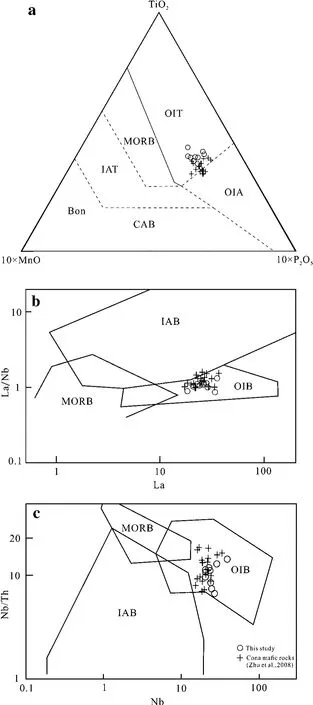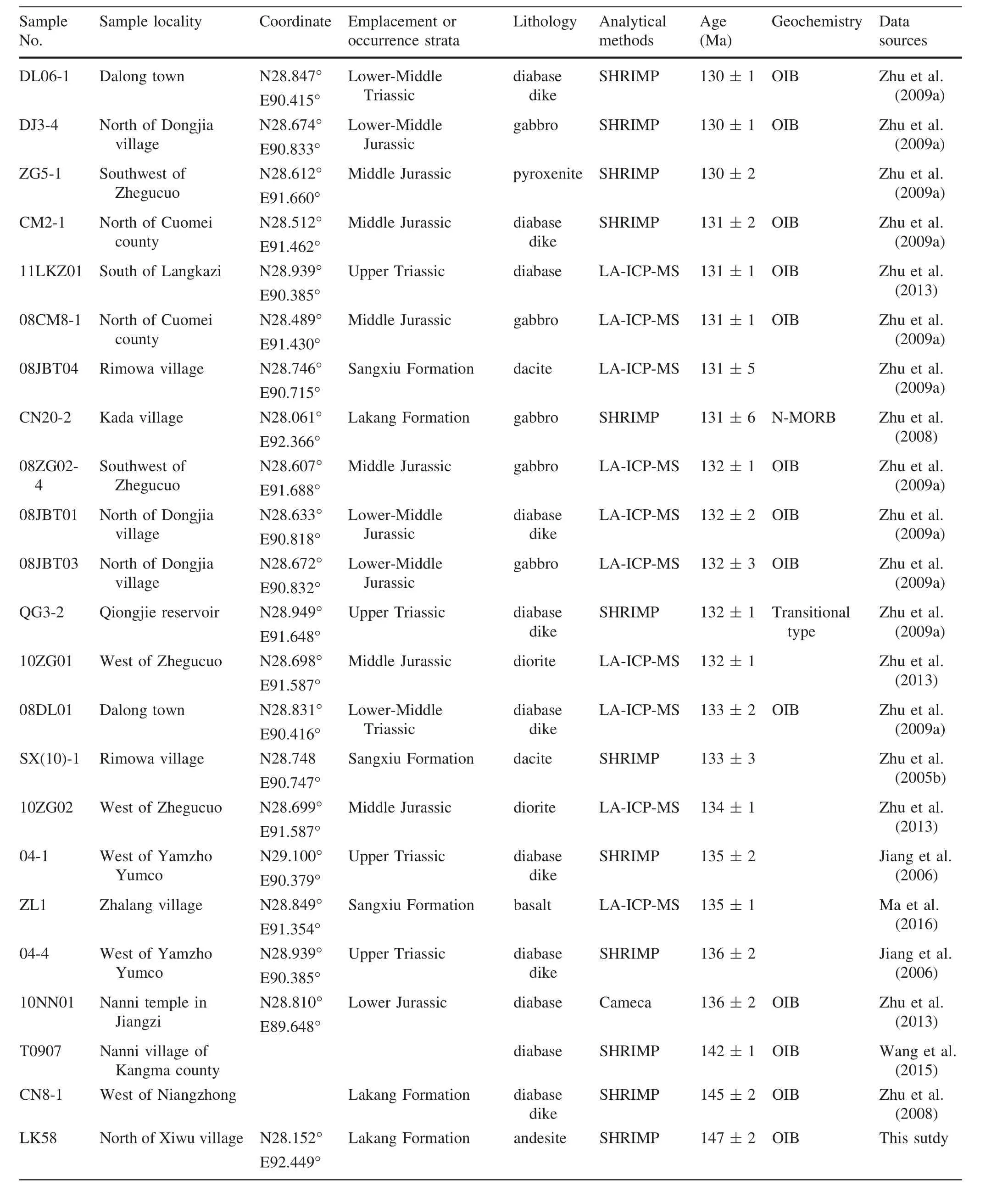Zircon SHRIMP U–Pb age of Late Jurassic OIB-type volcanic rocks from the Tethyan Himalaya:constraints on the initial activity time of the Kerguelen mantle plume
2018-07-04YuruoShiChenyangHouLawfordAndersonTianshuiYangYimingMaWeiweiBianJingjieJin
Yuruo Shi•Chenyang Hou,•J.Lawford Anderson•Tianshui Yang•Yiming Ma•Weiwei Bian•Jingjie Jin
1 Introduction
As one of the best-known Large Igneous Provinces,the Kerguelen Plateau in the South Indian Ocean(Fig.1a)is believed to be related to the igneous activity caused by the Kerguelen mantle plume(Storey et al.1992;Coffin et al.2002),which produced a huge amount of magmatic rocks from the Early Cretaceous to the present now widely dispersed from their original localities of emplacement due to the changing motions of the Antarctic,Australian,and Indian plates(Fig.1)(Mahoney et al.1983;Storey et al.1989,1992;Daviesetal.1989;Müller etal.1993;Frey etal.1996;Kent et al.1997,2002;Ingle et al.2002,2003,2004;Srivastavaet al.2005;Zhu et al.2005a,2008,2009a,2013;Chalapathi Rao et al.2014).The Bunbury Basalts(~132 Ma;Frey et al.1996;Coffin et al.2002)in southwestern Australiaand the Early Cretaceousigneousrocksof Cuomei area in the Tethyan Himalaya(~132 Ma;Jiang etal.2006;Zhu etal.2005b,2008,2009a,2013;Wang etal.2015;Liu et al.2015;Yang et al.2015;Maetal.2016)were thought to be the initial products of the Kerguelen mantle plume which was then in a continental marginal environment(Davies et al.1989;Duncan and Storey 1992;Kent et al.2002;Ingle et al.2002,2004;Zhu et al.2009a,2013).The Kerguelen mantle plume also played a significant role in the breakup of eastern Gondwanaland(Ingle et al.2002;Coffin et al.2002;Zhu et al.2008,2009a,b,2013).Some have argued that southwest Australia was too far from the location of the mantle plume(Frey et al.1996;Coffin et al.2002)and that the small volume of Bunbury Basalts(~103km3;Coffin et al.2002)and the Early Cretaceous igneous rocksin the Tethyan Himalaya(~104km3;Liu et al.2015)are incompatible with the typical mantle plume model(~105–106km3;Larson 1991).Past work has concluded thatthe Rajmahal Traps(~118 Ma;Kent et al.1997,2002)were the first manifestation attributable to the Kerguelen mantle plume.However,the age of the Rajmahal Traps is younger thanthebreakup of Indiaand Australia(~132 Ma;
Powell et al.1988).In contrast,Zhu et al.(2008)has proposed that a diabase(145±2 Ma)with OIB-type geochemical features collected from the Tethyan Himalaya is related toearly Kerguelenplume-lithosphereinteractionand represents the initial activity of Kerguelen mantle plume during the latest Jurassic or earliest Cretaceous.

Fig.1 a The Kerguelen hot spot-related basalt provinces in the Indian Ocean region(after Coffin et al.2002;Zhu et al.2008)and b reconstructions of Eastern Gondwana at~132 Ma(after Schettino and Scotese 2001)

Fig.2 Regional geological map of the Tethyan Himalaya belt(after Yin and Harrison 2000;Yin 2006).BNS Bangong–Nujiang suture,IYS Indus–Yarlung suture,JRS Jinshajiang–Red river suture,MCT main central thrust,STDS south Tibet detachment system
Mesozoic igneous rocks are widely distributed in the Tethyan Himalaya.Volcanic rocks interbedded with sedimentary rocks,mainly occur in the Sangxiu and the Lakang Formations.Zhu et al.(2005a,2007)reported the chronology and geochemical data of the Sangxiu Formation volcanic rocks from the central segment of the Tethyan Himalaya,south Tibet.The Sangxiu felsic rocks,including A-type granite,have been dated at~133 Ma(Zhu et al.2005b).The underlying Sangxiu basalts characterized by OIB-type geochemical characteristics were interpreted as a consequence of an interaction between the Kerguelen hotspot and the lithosphere of the northeastern margin of India(Zhu et al.2007).However,prior work on the volcanic rocks from the Lakang Formation was limited,and the exact formation time of the Lakang Formation and origin of the volcanic rocks were until now unknown.
In this contribution,we provide new geochronological and geochemical data of the Lakang Formation volcanic rocks from the Tethyan Himalaya.We further discuss their origin and constrain the initial activity time of the Kerguelen mantle plume.
2 Geological setting and samples
The Indus-Yarlung suture(IYS)separates the Tethyan Himalayaonthesouthfromthe Lhasaterraneonthenorthand is the widely accepted geological boundary between crustal unitsof Indian and Eurasian affinity(e.g.,Gansser 1980;Yin and Harrison 2000).The India-Eurasia collision and continued convergenceled to the Himalayanorogeny,whosemajor structures include the South Tibetan Detachment System(STDS),Main Central Thrust(MCT),Main Boundary Thrust(MBT),and Main Frontal Thrust(MFT).The Tethyan Himalaya,whichpaleogeographically belongstothenorthern margin of India,islocated between the Indus-Yalung Suture(IYS)and the South Tibetan Detachment System(STDS)(Fig.2),and consists of Proterozoic to Eocene sedimentary rocks with interbeds of Paleozoic and Mesozoic volcanic rocks(Yin 2006).The latter are widely distributed in the Tethyan Himalayaand mainly occur inthe Lower Cretaceous Sangxiu Formation and Lakang Formation.
The study area is located in the southeastern Tethyan Himalaya where the Lakang Formation volcanic-sedimentary rocks are widely distributed.The upper part of the Lakang Formation(K1l2)is mainly composed of sedimentary rocks,while the lower part(K1l1)consists of volcanic rockswhich includemassivebasalts,basaltic andesites,and someandesitesinterbedded withsedimentary rocks(Fig.3).Samplesfor thisstudy werecollected from3localitiesin the Lakang Formation volcanic rocks(Fig.3).

Fig.3 Simplified geological map of the sampling area(after Yang et al.2015)
The basalt and basaltic andesite samples(Fig.4a,c)are porphyritic(Fig.4b,d)with phenocrysts(0.5~1 mm in size)of plagioclase(10%)and minor pyroxene.Both plagioclase and pyroxene are subhedral and occur in a groundmass(90%of the rock)dominated by microcrystalline plagioclase,pyroxene and volcanic glass along with secondary chlorite and epidote.
The andesite sample(Fig.4e)is porphyritic(Fig.4f)with phenocrysts(0.5~1 mm in size)comprised of subhedral plagioclase(30%)and hornblende(10%).The groundmass accounts for 60%of the rock and is dominated by microcrystalline plagioclase and volcanic glass also with secondary chlorite and epidote.
3 Analytical methods
Zircons were extracted from ca.20 kg of fresh rock.The crushed sample was panned,followed by electromagnetic isodynamic heavy mineral separation.Approximately 100 grainsof thesamplewerethen handpicked using abinocular microscope.These were mounted onto an epoxy resin disc togetherwithseveral grainsof thestandardzircon TEMORA(Blacketal.2003)andthengrounddownandpolishedsothat their interiors were exposed.Zircons were then photographed by optical microscopy,and cathodoluminescence(CL)images were obtained using a HITACHI S-3000 N SEM with accelerating voltage of 10 kV and an electron current of 100 μA.U–Th–Pb analyses were performed during several analytical sessionsusing the SHRIMPIIinstrument at the Beijing SHRIMPCenter,Institute of Geology,Chinese Academy of Geological Sciences.Mass resolution during the analytical sessions was~5000(1%definition).Spot sizes were 25~30 μm and each site was rastered for 120~180 s prior to analysis to remove the gold coat.Five scans on90Zr216O+,204Pb+,background,206Pb+,207Pb+,208Pb+,238U+,232Th16O+,238U16O+weremade.Analytical procedures follow those of Williams(1998).Data were processed and assessed using the software programs Squid(Ludwig 2001)and Isoplot(Ludwig 2003).Common Pb correction wasmadeusingthemeasured204Pb and applying thevaluesof Stacey and Kramers(1975);Analytical results are listed in Table 1.Uncertainties for each analysis are at 1σ,whereastheweighted mean ageisquoted at 2σ.
Whole rock samples were crushed,contamination-free,to less than 200 mesh.Major and trace elements were analyzed by XRF(X-ray fluorescence spectrometry)and ICP-MS(Inductively coupled plasma mass spectrometry)respectively at Acme Analytical Lab,Canada.The precision for major elements is about 5%,for trace element analyses it is generally better than 10%.The analytical results are listed in Table 2.

Fig.4 Photographs showing field occurrences and photomicrographs of samples.a,b basalt sample LK4;c,d basalt sample LK60;e,f andesite sample LK58.For interpretation see the text
4 Results
4.1 Zircon SHRIMP U–Pb age
Zircons from the andesite sample(LK58)are 50–100 μm long,20–50 μm wide,often elongate,and characterized by high Th/U ratios(1.01~1.65,Table 1)with homogeneous luminescence (Fig.5)typical of magmatic zircons.Seventeen analysis on 17 zircon grains yielded206Pb/238U ages ranging from 140.7 to 155.1 Ma(Table 1)with a weighted mean age of 147±2 Ma(MSWD=1.5;Fig.6),which we infer to be the volcanic age of the andesite and the magma eruption age of volcanic rocks in this section of the Lakang Formation.
4.2 Geochemistry
Basalt,basaltic andesite and andesite of the Lakang Formation(Fig.7a)mostly belong to the tholeiite series of Miyashiro(1974)(Fig.7b).They arehigh in TiO2(2.62%–4.25%)and P2O5(0.38%–0.68%)(Table 2),and are highly fractionated in LREE/HREE[(La/Yb)N=5.35–8.31]with no obvious anomaly of Eu(Fig.8a).They also exhibit HFSE enrichment with no obvious anomaly of Nb,Ta(Fig.8b).The REE patterns(Fig.8a)and trace element spidergrams(Fig.8b,c)of thevolcanic rocksaresimilar to those of OIB.

Table 1 Zircon SHRIMPU–Pb analytical results of the volcanic rocks from the Lakang Formation in the Tethyan Himalaya
5 Discussion
5.1 Origin of the volcanic rocks from Lakang Formation
Most samples of the volcanic rocks are basaltsand basaltic andesites,and one sample with high SiO2content is an andesite (Fig.7a),which were collected from the interbedded volcanic rocks with basalts.Their overall chemistry indicated above suggests a mantle plume origin.In the MnO–TiO2–P2O5plot(Fig.9a,Mullen 1983),La–La/Nb(Fig.9b)and Nb–Nb/Th diagrams(Fig.9c),the datafall in the field of OIT(ocean island tholeiites)or OIB(ocean island basalts),which is generally believed to be related to mantle plumes(Hofmann and White 1982;Davies and Richards 1992).
A large number of investigations have been performed on the Early Cretaceous igneous rocks which are widely distributed in the Tethyan Himalaya(Fig.10;Jiang et al.2006;Zhu et al.2005a,2005b,2008,2009a,2013;Wang et al.2015;Ma et al.2016).The magma activity mainly occurred during 130~136 Ma(peaked at~132 Ma)(Table 3;Fig.11).Zhu et al.(2009a)proposed that the igneous rocks in the Cuomei area and the Bunbury Basalts may represent the remnants of Cuomei–Bunbury LIP(Fig.1b)and related to the Kerguelen mantle plume(Zhu et al.2009a,2013).Although most of the zircon U–Pb ages in Cuomei area range from 130 to 136 Ma,a few ages older than 140 Ma also exist(Table 3).The diabase sills with an age of 145±2 Ma that cut the 147 Ma Lakang Formation are also likely related to the Kerguelen mantle plume(Zhu et al.2008).The volcanic rocks from the Lakang Formation are located in the southeast of the Cuomei area(Fig.10),and their OIB-like characteristics indicate a mantleplume origin which weconcludeto be the earliest activity of Kerguelen mantle plume.
5.2 The initial activity time of Kerguelen mantle plume
After enormous level of magmatism,the head of a mantle plume is inferred to have cooled rapidly as the magma activity ceased.However,volcanoes attributed to somemantle plumes,such as the Kerguelen mantle plume,can intermittently erupt for more than 100 Ma(Frisch et al.2011).The products of the Kerguelen mantle plume are widely distributed in the eastern Indian Ocean region and the adjacent continental margin(Fig.1a).The Rajmahal Traps(~118 Ma)which have been widely accepted as the product of the Kerguelen mantleplumewereonceregarded as the first manifestation of this mantle plume(Kent et al.1997,2002).

Table 2 Major and trace elements of the volcanic rocks from the Lakang Formation

Fig.5 Cathodoluminescence imagesand SHRIMPU–Pb ages of some representative zircons of the volcanic rocks(sample LK58)from the Lakang Formation

Fig.6 U–Pb concordia diagram and 206Pb/238U age variation of zircons from the volcanic rocks of the Lakang Formation
The Bunbury Basalts(~132 Ma)in southwestern Australia,which preceded the Rajmahal Traps by~14 Ma,were not believed to be attributed to the Kerguelen mantle plume because of their small volume(Coffin et al.2002)and the large distance(~800–1200 km)between the mantle plume and southwest Australia(Frey et al.1996;Coffin et al.2002).However,previous studies show that the Kerguelen mantle plume was beneath the triple junction of India,Australia and Antarctica at~130 Ma(Davies et al.1989;Curray and Munasinghe 1991),and it moved southward 3°–10°since ca.120 Ma(Antretter et al.2002).Hence,the distance may be not a convincing argument against the relationship between the mantle plume and the Bunbury Basalts(Ingle et al.2004;Zhu et al.2008).The volume of Bunbury Basalts is only 103km3(Coffin et al.2002),which is not consistent with the typical model of mantle plumes(~105–106km3;Larson 1991).However,Coffin et al.(2002)suggested that the initial Kerguelen plume head might have broken into‘‘droplets’’of variable sizes within the rapidly convecting upper mantle,resulting in spatially and temporally displaced magmatic events of differing volumes,all ultimately related to the Kerguelen mantle plume.

Fig.7 TASdiagram(a;Le Bas et al.1986),and SiO2 versus FeO/(FeO+MgO)plot(b;Miyashiro 1974)of the volcanic rocks from the Lakang Formation
Zhu et al.(2009a)proposed that the Bunbury Basalts and the Early Cretaceousigneousrocksin Cuomei area are genetically related and constitute the erosional and/or deformational remnants of the Cuomei–Bunbury LIP and were also caused by the Kerguelen mantle plume.Further studies have indicated that theinitial Cuomei–Bunbury LIP may be much larger than the extent identified today(Qiu et al.2010;Zhu et al.2013).Liu et al.(2015)argued that the small volume of the Cuomei–Bunbury basalts(~1.1 × 104km3)are attributed to the high pressure that resulted from the thick lithosphere(>150 km in depth)underneath India at~132 Ma,which may have prevented the Kerguelen plume from causing large-scale melting.All of these indicate that the Bunbury Basalts and the Early Cretaceous igneous rocks in Cuomei area are indeed related to the Kerguelen mantle plume.Therefore,some investigators suggested the initial activity of the Kerguelen mantleplumemight havebegun asearly as~132 Ma(Zhu et al.2009b,2013),if not earlier.

Fig.8 Chondrite-normalized REE patterns(a.chondrite values are from Boynton 1984),trace element spidergrams(b.primitive mantle values are from Sun and McDonough 1989),trace element spidergrams(c.ocean island basalts values are from Sun and McDonough 1989)of the volcanic rocks from the Lakang Formation

Fig.9 MnO-TiO2-P2O5 diagram(a,after Mullen 1983)and La–La/Nb(b,after Li1993)and Nb–Nb/Th(c,after Li1993)diagramsof the volcanic rocks from the Lakang Formation

Fig.10 Simplified geological map of the Cuomei large igneous province(after Zhu et al.2009a;Qiu et al.2010)
The existence of igneous rocks older than 140 Ma(Zhu et al.2008;Wang et al.2015;This study)makes the initial activity time of the Kerguelen mantle plume an open question.The diabase sills with an age of 145±2 Ma that cut the Lakang Formation could as well be attributed to the Kerguelen mantle plume(Zhu et al.2008).To better interpret the petrogenesis of these igneous rocks,Zhu et al.(2008)proposed a Kerguelen mantle plume model combined with the genetic explanations proposed by Kent(1991),Kent et al.(1992),and Coffin et al.(2002).In this contribution,the volcanic rocks from Lakang Formation(147±2 Ma)with their OIB-like geochemical features were inferred to suggest a mantle plume origin with the Kerguelen mantle plume beginning to form during the Late Jurassic.
We propose that the initial activity of Kerguelen mantle plume is earlier than the breakup of eastern Gondwanaland(~132 Ma;Powell et al.1988),which provides the possibility that the Kerguelen mantle plume affected its breakup.Besides,the large-scale magmatism in Cuomei–Bunbury LIP is coeval with the oldest magnetic anomaly(~131 Ma)identified between the southwestern Australia and northeastern India(Heine and Müller 2005),suggesting that the Kerguelen mantle may have played a significant role in the breakup of eastern Gondwanaland.

Table 3 Zircon U–Pb ages of the igneous rocks related to Kerguelen mantle plume in the Tethyan Himalaya

Fig.11 Histograms of zircon U–Pb ages of igneous rocks related to Kerguelen mantle plume in Tethyan Himalaya
6 Conclusions
We report new geochronological and geochemical results of volcanic rocks from the Lakang Formation in the southeastern Tethyan Himalaya.SHRIMPU–Pb dating of zircons from the volcanic rocks yield a206Pb/238U age of 147±2 Ma that reflects the time of Late Jurassic magmatism.The same volcanic rocks are similar to those of ocean island basalts(OIB)and indicate a mantle plume origin.Hence,we conclude that thevolcanic rocksfrom the Lakang Formation represent the earliest activity of Kerguelen mantleplume,which started from the Late Jurassic,and played a significant role in the breakup of eastern Gondwanaland.
AcknowledgementsWe appreciate the editorial patience of Binbin Wang and Congqiang Liu.Thecommentsof theanonymousreviewers are gratefully acknowledged.This study was financially supported by the National Natural Science Foundation of China(Nos.41173065,41572205),the Geological Survey of China(Grant no.DD20160345),and Ministry of Science and Technology(No.2012FY120100).We thank membersof the Beijing SHRIMPCenter for their help of zircon SHRIMPanalysis and cathodoluminescence image.
Antretter M,Steinberger B,Heider F,Soffel H(2002)Paleolatitudes of the Kerguelen hotspot:new paleomagnetic results and dynamic modeling.Earth Planet Sci Lett 203:635–650
Black LP,Kamo SL,Allen CM,Aleinikoff JN,Davis DW,Korsch RJ,Foudoulis C(2003)TEMORA 1:a new zircon standard for phanerozoic U–Pb geochronology.Chem Geol 200:155–170
Boynton WV(1984)Geochemistry of the rare earth elements:Meteorite studies.In:Henderson P(ed)Rare Earth element geochemistry.Elsevier,New York,pp 63–114
Chalapathi Rao NV,Srivastava RK,Sinha AK,Ravikant V(2014)Petrogenesis of Kerguelen mantle plume-linked Early Cretaceous ultrapotassic intrusive rocks from the Gondwana sedimentary basins,Damodar Valley,eastern India.Earth Sci Rev 136:96–120
Coffin MF,Pringle MS,Duncan RA,Gladczenko TP,Storey M,Müller RD,Gahagan LA(2002)Kerguelen hotspot magma output since 130 Ma.JPetrol 43:1121–1139
Curray IR,Munasinghe T(1991)Origin of the Rajmahal trapsand the 85°Eridge preliminary reconstructions of the trace of the Crozet hotspot.Geology 19:1237–1240
Davies GF,Richards MA (1992)Mantle convection.J Geol 100:151–206
Davies HL,Sun SS,Frey FA,Gautier I,McCulloch MT,Price RC,Bassias Y,Klootwijk CT,LeClaire L(1989)Basalt basement from the Kerguelen Plateau and the trail of a Dupal plume.Contrib Miner Petrol 103:457–469
Duncan RA,Storey M(1992)Thelifecycleof Indian Ocean hotspots.In:Duncan RA,Rea DK,Kidd RB,von Rad U,Weissel JK(eds)Synthesis of results from scientific drilling in the Indian Ocean,vol 70.Geophysical Monograph.American Geophysical Union,Washington,pp 91–103
Frey FA,McNaughton NJ,Nelson DR,Delaeter JR,Duncan RA(1996)Petrogenesis of the Bunbury Basalt,western Australia:Interaction between the Kerguelen plume and Gondwana lithosphere?Earth Planet Sci Lett 144:163–183
Frisch W,Mesched M,Blakey R(2011)Plate tectonics.Springer,Heidelberg
Gansser A(1980)The significance of the Himalayan suture zone.Tectonophysics 62(1–2):37–52
Heine C,Müller RD(2005)Late jurassic rifting along the Australian north west shelf:margin geometry and spreading ridge configuration.Aust JEarth Sci 52:27–39
Hofmann AW,White WM(1982)Mantle plumes from ancient oceanic crust.Earth Planet Sci Lett 57:421–436
Ingle S,Weis D,Scoates J,Frey F(2002)Relationship between the early Kerguelen plumeand continental flood basaltsof thepaleoeastern Gondwanan margins.Earth Planet Sci Lett 197:35–50
Ingle S,Weis D,Doucet S,Mattielli N(2003)Hf Isotope constraints on mantle sources and shallow-level contaminants during Kerguelen hotspot activity since~120 Ma.Geochem Geophys Geosyst.doi:10.1029/2002GC000482
Ingle S,Scoates JS,Weis D,Brügmann G,Kent RW(2004)Origin of Cretaceous continental basalts in southwestern Australia and eastern Indian:insights from Os and Hf isotopes.Chem Geol 209:83–106
Jiang SH,Nie FJ,Hu P,Liu Y(2006)An important spreading event of the Neo-Tethys Ocean during the Late Jurassic and Early Cretaceous:evidence from zircon U–Pb SHRIMP dating on diabase in Nagarze,southern Tibet.Acta Geol Sin 80:522–527
Kent RW(1991)Lithospheric uplift in eastern Gondwana:Evidence for a long-lived mantle plume system?Geology 19:19–23
Kent RW,Storey M,Saunders AD(1992)Large igneous provinces:Sites of plume impact or plume incubation? Geology 20:891–894
Kent RW,Saunders AD,Kempton PD,Ghose NC(1997)Rajmahal basalts,eastern India:mantle sources and melt distribution at a volcanic rifted margin.In:Mahoney JJ,Coffin MF(eds)Large igneous provinces:continental,oceanic and planetary flood volcanism,vol 100.Geophysical monograph.American Geophysical Union,Washington,pp 145–182
Kent RW,Pringle MS,Müller RD,Saunders AD,Ghose NC(2002)40Ar/39Ar geochronology of the Rajmahal basalts,India,and their relationship to the Kerguelen Plateau. J Petrol 43:1141–1153
Larson RL(1991)Geological consequencesof superplumes.Geology 19:963–966
Le Bas MJ,Le Maitre RW,Streckeisen A,Zanettin B(1986)A chemical classification of volcanic rocks based on the total alkali-silica diagram.JPetrol 27:745–750
Li SG(1993)Ba-Nb-Th-La diagrams used to identify tectonic environments of ophiolite.Acta Petrologic Sinica 9:146–157(in Chinese with English abstract)
Liu Z,Zhou Q,Lai Y,Qing CS,Li YX,Wu JY,Xia XB(2015)Petrogenesis of the Early Cretaceous Laguila bimodal intrusive rocks from the Tethyan Himalaya:implications for the break-up of Eastern Gondwana.Lithos 236:190–202
Ludwig KR (2001)Squid 1.02:A user’s manual,Berkeley geochronology centre.Special publication 2,1–19
Ludwig KR(2003)User’s manual for Isoplot 3.00,a Geochronological toolkit for microsoft excel.Berkeley geochronology center
Ma YM,Yang TS,Bian WW,Jin JJ,Zhang SH,Wu HC,Li HY(2016)Early Cretaceous paleomagnetic and geochronologic results from the Tethyan Himalaya:insights into the Neotethyan paleogeography and the India-Asia collision.Sci Rep 6:21605
Mahoney JJ,Macdougall JD,Lugmair GW,Gopalan K(1983)Kerguelen hot spot source for Rajmahal traps and ninetyeast ridge?Nature 303:385–389
Miyashiro A(1974)Volcanic rock series in island arcs and active continental margins.Am JSci 274:321–355
Mullen ED(1983)MnO/TiO2/P2O5:a minor element discriminant for basaltic rocks of oceanic environments and its implications for petrogenesis.Earth Planet Sci Lett 62:53–62
Müller RD,Royer JY,Lawver LA(1993)Revised plate motions relative to the hotspots from combined Atlantic and Indian Ocean hotspot tracks.Geology 16:275–278
Powell CM,Roots SR,Veevers JJ(1988)Pre-breakup continental extension in East Gondwanaland and the Early Cretaceous opening of the eastern Indian Ocean. Tectonophysics 155:261–283
Qiu BB,Zhu DC,Zhao ZD,Wang LQ(2010)The westward extension of Comei fragmented large igneous province in southern Tibet and its implications.Acta Petrologica Sinica 26:2207–2216(in Chinese with English abstract)
Schettino A,Scotese CR(2001)New internet software aids paleomagnetic analysis and plate tectonic reconstructions.Eos(Transactions,American Geophysical Union)82,530–536
Srivastava RK,Heaman LM,Sinha AK,Shihua S(2005)Emplacement age and isotope geochemistry of Sung Valley alkalinecarbonatite complex,Shillong Plateau,northeastern India:implications for primary carbonate melt and genesis of the associated silicate rocks.Lithos 81:33–54
Stacey JS,Kramers JD(1975)Approximation of terrestrial lead isotope evolution by a two-stage model.Earth Planet Sci Lett 26:207–221
Storey M,Saunders AD,Tarney J,Gibson IL,Norry MJ,Thirlwall MF,Leat P,Thompson RN,Menzies MA(1989)Contamination of Indian Ocean asthenosphere by the Kerguelen–Heard mantle plume.Nature 338:574–576
Storey M,Kent RW,Saunders AD,Salters VJ,Hergt J,Whitechurch H,Sevigny JH,Thirlwall MF,Leat P,Ghose NC,Gifford M(1992)Lower Cretaceous volcanic rocks on continental margins and their relationship to the Kerguelen Plateau.In:Wise SW,Schlich R(eds)Proceedings of the Ocean drilling program,scientific results 12:college station,TX (Ocean Drilling Program),pp 33–53
Sun SS,McDonough WF(1989)Chemical and isotopic systematics of oceanic basalts:implications for mantle composition and processes.In:Saunders AD,Norry MJ(eds)Magmatism in the Ocean basins.Geological Society,Special Publications,London,vol 42,pp 313–345
Wang YY,Zeng LS,Gao LE,Gao JH,Shang Z(2015)Geochemical characteristic of the Early Cretaceous diabase and its implication from Jiangzi-Kangma in Tethyan Himalaya,south Tibet.Acta Geological Sinica 89:345–348(in Chinese with English abstract)
Williams IS(1998)U–Th–Pb geochronology by ion microprobe.In:McKibben MA,Shanks WCIII,Ridley WI(eds)Applicationsof microanalytical techniques to understanding mineralizing processes.Reviews in economic geology.Society of Economic Geologists,Littleton,pp 1–35
Yang TS,Ma YM,Bian WW,Jin JJ,Zhang SH,Wu HC,Li HY,Yang ZY,Ding JK(2015)Paleomagnetic results from the Early Cretaceous Lakang Formation lavas:constraints on the paleolatitude of the Tethyan Himalaya and the India-Asia collision.Earth Planet Sci Lett 428:120–133
Yin A(2006)Cenozoic evolution of the Himalayan Orogen as constrained by alongstrike variations of structural geometry,exhumation history,and foreland sedimentation.Earth Sci Rev 76:1–134
Yin A,Harrison TM(2000)Geologic evolution of the Himalayan–Tibetan orogeny.Annu Rev Earth Planet Sci 28:211–280
Zhu DC,Pan GT,Mo XX,Liao ZL,Jiang XS,Wang LQ,Zhao ZD(2005a)Geochemistry and petrogenesis of the Sangxiu Formation basalts in the central segment of Tethyan Himalaya.Geochimica 34:7–19(in Chinese with English abstract)
Zhu DC,Pan GT,Mo XX,Wang LQ,Liao ZL,Jiang XS,Geng QR(2005b)SHRIMP U–Pb zircon dating for the dacite of the Sangxiu Formation in the central segment of Tethyan Himalaya and its implications.Chin Sci Bull 50:563–568(in Chinese)
Zhu DC,Pan GT,Mo XX,Liao ZL,Jiang XS,Wang LQ,Zhao ZD(2007)Petrogenesis of volcanic rocks in the Sangxiu Formation,central segment of Tethyan Himalayas:a probable example of plume–lithosphere interaction.JAsian Earth Sci 29:320–335
Zhu DC,Mo XX,Pan GT,Zhao ZD,Dong GC,Shi YR,Liao ZL,Wang LQ,Zhou CY(2008)Petrogenesis of the earliest Early Cretaceous maficrocks from the Cona area of the eastern Tethyan Himalaya in south Tibet:Interaction between the incubating Kerguelen plume and the eastern Greater India lithosphere?Lithos 100:147–173
Zhu DC,Chung SL,Mo XX,Zhao ZD,Niu YL,Song B,Yang YH(2009a)The 132 Ma Comei–Bunbury large igneous province:remnants identified in present-day southeastern Tibet and southwestern Australia.Geology 37:583–586
Zhu DC,Mo XX,Zhao ZD,Niu YL,Pan GT,Wang LQ,Liao ZL(2009b)Permian and Early Cretaceous tectonomagmatism in southern Tibet and Tethyan evolution:new perspective.Earth Sci Front 16:1–20(in Chinese with English abstract)
Zhu DC,Xia Y,Qiu BB,Wang Q,Zhao ZD(2013)Why do we need to propose the Early Cretaceous Comeilargeigneousprovince in southeastern Tibet?Acta Petrologica Sinica 29:3659–3670(in Chinese with English abstract)
杂志排行
Acta Geochimica的其它文章
- Geochronological and geochemical constraints on the Cuonadong leucogranite,eastern Himalaya
- Geochemistry and geochronology of Late Jurassic and Early Cretaceous intrusions related to some Au(Sb)deposits in southern Anhui:a case study and review
- Re–Os dating of molybdenite and in-situ Pb isotopes of sulfides from the Lamo Zn–Cu deposit in the Dachang tin-polymetallic ore field,Guangxi,China
- Major Miocene geological events in southern Tibet and eastern Asia induced by the subduction of the Ninetyeast Ridge
- Using electrogeochemical approach to explore buried gold deposits in an alpine meadow-covered area
- U–Pb zircon age of the base of the Ediacaran System at the southern margin of the Qinling Orogen
